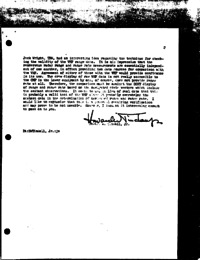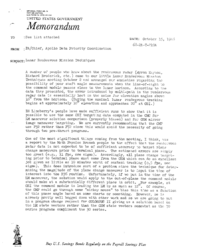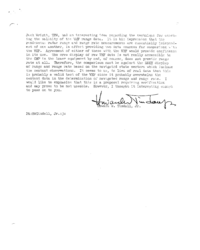See list attachedOctober 15, 196868-PA-T-219APA/Chief, Apollo Data Priority CoordinationLunar Rendezvous Mission Techniques
A number of people who know about the rendezvous radar (Myron Kayton, Richard Broderick, etc.) came to our little Lunar Rendezvous Mission Techniques meeting October 2 and assuaged our anxieties regarding the possibility of poor shaft angle measurements when the line-of-sight to the command module passes close to the lunar horizon. According to the data they presented, the error introduced by multi-path in the rendezvous radar data is essentially lost in the noise for elevation angles above 10° from the horizon. (During the nominal lunar rendezvous tracking begins at approximately 10° elevation and approaches 20° at CSI.)
Ed Lineberry's people have made sufficient runs to show that it is possible to use the same CSI targeting data computed in the CMC for LM maneuver solution comparison (properly biased) and for CSM mirror image maneuver targeting. We are currently recommending that the CMP use P32 rather than P72 since this would avoid the necessity of going through two pre-thrust programs.
One of the most significant things coming from the meeting, I think, was a report by the Math Physics Branch people to the effect that the rendezvous radar data is not expected to be of sufficient accuracy to target plane change maneuvers prior to terminal phase. The estimated errors are simply too great (e.g., 11 fps, one sigma). Accordingly, all plane change target- ing prior to terminal phase must come from the CSM which can do an excellent job given as little as 10 minutes worth of sextant tracking (0.5 fps, one sigma). This does introduce sort of a problem since the technique for deter- mining the magnitude of the plane change maneuver is to input the time of interest into the R36 routine. Unfortunately, if we put in the time of the LM maneuver, the solution would apply to the out-of-plane the command module should make at a substantially different place in orbit. For example, at CSI the command module is leading the LM by as much as 12°. Of course, the CMP could go through some “mickey mouse” to bias this time as a function of this phase angle based on some charts or something. However, he is already pretty well bogged down with other work and so we are going to put in a program change request for COLOSSUS II giving us a solution based on the LM state vectors rather than the CSM state vectors somewhat as the 70 series programs compliment the 30 series.
Jack Wright, TRW, had an interesting idea regarding the technique for check- ing the validity of the VHF range data. It is his impression that the rendezvous radar range and range rate measurements are essentially independ- ent of one another, in effect providing two data sources for comparison with the VHF. Agreement of either of these with the VHF would provide confidence in its use. The crew display of raw VHF data is not really accessible to the CMP in the lower equipment by and, of course, does not provide range rate at all. Therefore, the comparison must be against the DSKY display of range and range rate based on the navigated state vectors which include the sextant observations. It seems to us, in lieu of real data that this is probably a valid test of the VHF since it probably overwhelms the sextant data in the determination of navigated range and range rate. I would like to emphasize that this is a proposal requiring verification and may prove to be not useable. However, I thought it interesting enough to pass on to you.
- Nov 15, 1968 – F Rendezvous Mission Techniques (4.5σ)






